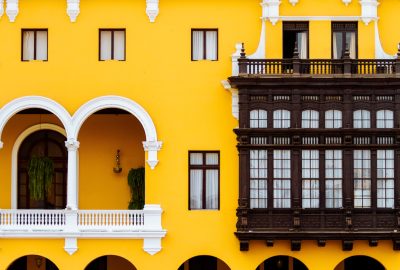Travelling to Peru has become synonymous with visiting Machu Picchu. But despite the magnificence of this ancient world wonder in the Andes, this does not justice to what the rest of the country and its capital have to offer. Believe me: Lima is a fascinating city and definitely deserves a longer stay on its own. I always thought that all the colonial capitals of Latin America are the same. The historical city centres, the colourful favelas, beaches, and grilled meat; you know all that jazz. But not Lima: Lima is so much different. One look at this coastal capital and you think: “this is so fragile, how is it still standing”. It looks like how the entire coastline is one earthquake away from collapsing. Think about it when you’re sipping gin at one of those cliff cafés. Lima is a mystical city built on the ruins of an ancient civilization. People have lived in these mountainous lands long before Columbus. As a matter of fact, even long before the Incas. There are well-preserved ruins of an almost 200 years old pyramid. Standing in the middle of the city, just like that. They even uncovered a tomb with two intact adult bodies and a child sacrifice. That was normal stuff back in those days.

Machu Picchu, the mysterious and magnificent Inca settlement of the 15th century is the main attraction of Peru and probably of entire Latin America, to get there from Lima you will need to travel to the city of Cusco
Those traditions are still practiced here and there in Peru. Not as savage since you can’t just grab a kid and cut its heart out anymore. Brujeria is a bit of an obscure belief system. It’s a combination of Christianity, witchcraft and their indigenous rituals; so a bit like Haitian Vodou. You can learn more about all that and do a bit of shopping at the Witches Market. Mercado de Bruja is a part of the Gamarra Market, next to the train station. What sort of stuff can you buy there? Candles, ointments, talismans, dried lizards. You can even consult a witch doctor or a healer. That’s just over the counter supplies. I wonder what kinds of trades happen behind the scenes. It’s also a place where you can get ripped off easily. Honestly, how do put a price on a dried llama foetus? How do you measure its quality?
The market is just the beginning of the creepy side of Lima. The ossuary in Convento de St Francisco has been rediscovered in 1943. It used to be a thing back in the day. Many churches in Europe have ossuaries and it never ceases to amaze me. They had limited graveyard space, so they buried people just for a little while. The remains were exhumed a few years later and moved to church basements in order to create pretty art. It was a foolproof plan. The clergy got free décor and more space to bury people in the cemetery. The ossuary wasn’t the only thing they discovered in 1943. Turns out that there are underground tunnels connecting most churches in Lima.

The Palacio Municipal de Lima (the City Hall of Lima): a beautiful building in colonial style on Plaza Mayor or Plaza de Armas of Lima in the old city centre
The majority of Lima’s citizens are Roman Catholics. I think it’s awesome how they balanced their ancient religious customs with Christianity. There are some beautiful colonial churches in Lima, such as the breath-taking Cathedral. An inner chapel holds remains of Francisco Pizarro, Lima’s founding figure. He did what every other conquistador did: he arrived, butchered the locals and claimed the land for the Spanish Kingdom. He was a bit of a dick too. Pizarro bamboozled Atahualpa (the leader of the Incas) to parley as a sign of good faith. Then he captured him, collected ransom and still killed the guy. Glorious conquistadors.
Enough of this morbid talk: let’s have some fun! Lima is a Latin American capital, after all, people here love to party. There are two main entertainment areas in this city. Miraflores is the district where the suits go to sample the new Peruvian cuisine and sip on whisky in rooftop bars. Best clubs in town for the coolest kids. Barranco is more of an organic, cosy kind of area. Think of tiny, back alley watering holes packed with local artists and vagabonds. There’s an iconic bridge and a story of a misalliance between a noble and a street sweeper. Holding breath while crossing that bridge supposedly helps you find true love. Huaringas, one of the best bars in Lima, is nearby. They concoct all sorts of delicious pisco-based drinks (pisco is a Peruvian brandy). Barranco is also home to El Dragon de Barranco, Lima’s immensely popular dancing club, and frequented by stunning local women. It’s built into an old colonial manor and features live music and cultural events.





No one commented yet. Be the first.